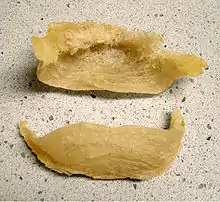Edible-nest swiftlet
The edible-nest swiftlet (Aerodramus fuciphagus), also known as the white-nest swiftlet, is a small bird of the swift family which is found in South-East Asia. Its nest is made of solidified saliva and is used to make bird's nest soup.
| Edible-nest swiftlet | |
|---|---|
 | |
| in flight | |
| Scientific classification | |
| Kingdom: | Animalia |
| Phylum: | Chordata |
| Class: | Aves |
| Order: | Apodiformes |
| Family: | Apodidae |
| Genus: | Aerodramus |
| Species: | A. fuciphagus |
| Binomial name | |
| Aerodramus fuciphagus (Thunberg, 1812) | |
 | |
| Synonyms | |
|
Collocalia fuciphaga | |
Description
The edible-nest swiftlet generally measures 14cm (5.5. in). The upper part of the body is blackish-brown; the under part of the body ranges in color from white to blackish-brown. The tail has a slight notch.[2]
It weighs 15 to 18 grams and the wings are long and narrow. The bill and feet are black.
The subspecies A. f. micans is paler and greyer while A. f. vestitus is darker with a rump that is less obviously paler.
At breeding colonies, the bird emits high-pitched and burbling calls. They also emit a rattling call used for echolocation.[3]
Distribution and subspecies
There are six subspecies of the edible-nest swiftlet:
- A. f. fuciphagus – The nominate subspecies found in Java, Bali and the western Lesser Sunda Islands
- A. f. inexpectatus – Andaman and Nicobar Islands, vagrant to Burma
- A. f. dammermani – Flores, known from only a single specimen
- A. f. micans – eastern Lesser Sundas (Sumba, Savu and Timor)
- A. f. vestitus – Sumatra and Borneo, sometimes considered to be a separate species, the brown-rumped swiftlet, Aerodramus vestitus (Lesson, 1843).
- A. f. perplexus – Maratua Archipelago off eastern Borneo
German's swiftlet (Aerodramus germani), with two subspecies germani and amechanus, was formerly considered to be conspecific with the edible-nest swiftlet, but is now often considered to be a separate species. It occurs in the Malay Peninsula, central Thailand, coastal Vietnam and Cambodia, Hainan, northern Borneo and parts of the Philippines.
Behavior
The edible-nest swiftlet feeds over a range of habitats from coastal areas to the mountains, occurring up to 2,800 metres above sea-level on Sumatra and Borneo. Its diet consists of flying insects which are caught on the wing. It often feeds in large flocks with other species of swiftlet and swallow.
It breeds in colonies in caves, in a cleft in a cliff or sometimes on a building. The bracket-shaped nest is white and translucent and is made of layers of hardened saliva attached to the rock. It measures about 6 cm across with a depth of 1.5 cm and a weight of about 14 grams. Two white, oval, non-glossy eggs are laid.
Relationship with humans

The nest used in bird's nest soup is composed entirely of saliva.[4] The soup is made by soaking and steaming the nests in water. It is said to improve kidney health, reduce phlegm, and to be an aphrodisiac.[5] The nests can fetch high prices and many colonies are harvested commercially.
Some populations such as those in the Andaman and Nicobar Islands have been harvested extensively leading to them being considered critically threatened under the IUCN criteria.[1][6]
The use of artificial bird houses is growing.[7] A detailed account of modern nest farming and marketing techniques is given by David Jordan (2004). In Indonesia and Malaysia , "farming" of nests is performed in purpose-built structures or old empty houses with "tweeters" playing recordings of bird calls on the roof to attract swiftlets. In urban areas, such "bird houses" may be considered a nuisance by neighbours due to the loud bird calls and bird feces.
References
- BirdLife International (2014). "Aerodramus fuciphagus". IUCN Red List of Threatened Species. 2014. Retrieved 29 August 2014.
- Jeyarajasingam, Allen (2012-03-22). A Field Guide to the Birds of Peninsular Malaysia and Singapore. Oxford University Press. ISBN 978-0-19-963942-7.
- Jeyarajasingam, Allen (2012-03-22). A Field Guide to the Birds of Peninsular Malaysia and Singapore. Oxford University Press. ISBN 978-0-19-963942-7.
- MANCHI, SHIRISH S.; SANKARAN, RAVI (2010). "FORAGING HABITS AND HABITAT USE BY EDIBLE-NEST AND GLOSSY SWIFTLETS IN THE ANDAMAN ISLANDS, INDIA". The Wilson Journal of Ornithology. 122 (2): 259–272. ISSN 1559-4491.
- "Bird's Nest Soup Is More Popular Than Ever, Thanks to Swiftlet House Farms". Audubon. 2017-10-23. Retrieved 2020-06-29.
- R. Sankaran (2001) The status and conservation of the edible-nest swiftlet (Collocalia fuciphaga) in the Andaman and Nicobar Islands. Biological Conservation 97:283–294
- Boyle, Joe (27 Jan 2011). "Welcome to Indonesia's bird nest soup factory town". BBC.
Further reading
- Chantler, Phil & Driessens, Gerald (2000) Swifts: A Guide to the Swifts and Treeswifts of the World, 2nd ed., Pica Press, East Sussex.
- Jordan, David, 2004,"Globalisation and Bird's Nest Soup" International Development Planning Review, Volume 26, Number 1, Liverpool Unviversity Press and https://web.archive.org/web/20081021051925/http://jordanresearch.co.uk/pubs.html
- MacKinnon, John & Phillipps, Karen (1993) A Field Guide to the Birds of Borneo, Sumatra, Java and Bali, Oxford University Press, Oxford.
- Robson, Craig (2002) A Field Guide to the Birds of South-East Asia, New Holland Publishers (UK) Ltd., London.
External links
| Wikispecies has information related to Aerodramus fuciphagus. |
| Wikimedia Commons has media related to Aerodramus fuciphagus. |
- Birds of India: Edible-nest Swiftlet
- Oriental Bird Images: Edible-nest Swiftlet
- Review of research
- The Kind of Indonesia Bird Nest
